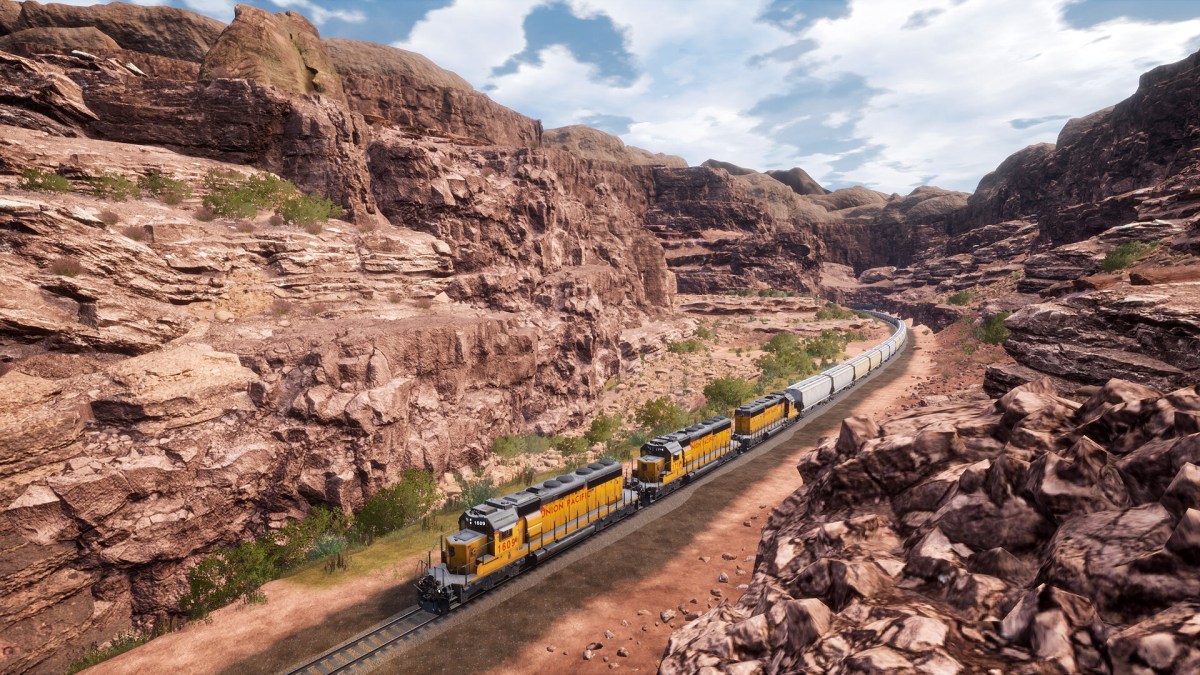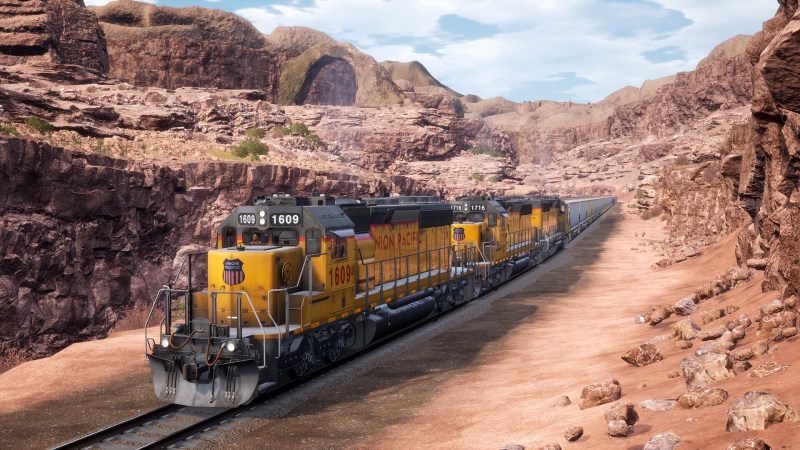Dovetail Games’ Train Sim World 2 is one of the latest entries in the long-running subgenre of train simulators. As such, the developers take a lot of pride in offering a defining level of realism in terms of both mechanics, features, and graphical capabilities. In fact, a lot of these features are attributed to the capabilities of Unreal Engine. Just recently, we got the chance to conduct an interview with some of the devs behind the upcoming Cane Creek expansion for Train Sim World 2 — a route based in a rugged part of Utah, US. This provided the chance for the experts to explain some of what goes into the production of such an elaborate project with the intent to recreate a real-life location in “game” form.
The following answers were kindly provided by Lewis McDonough, who is the Environment Artist from Skyhook Games (the studio behind the Cane Creek expansion). David Harper, the Managing Director at Skyhook, also chipped in with some input. Here’s what the designers had to say about this complex undertaking:
PCI: How do the designers go about gathering the real scenery data to replicate it in Train Sim World 2?
McDonough: As a starting point, we use a variety of online resources such as LIDAR (real-world satellite data), as well as things you’d expect such as Google Earth and YouTube. Google Earth is extremely useful throughout development as a reference point to make sure we’re recreating the route area as best we can.
We’re also lucky to have a great network of individuals world-wide, including in the US, who have great knowledge about their local routes and lines – this is invaluable in helping us remain authentic.
PCI: How long does a typical new environment take to complete?
McDonough: There are a huge array of factors that can affect the time it takes to create a new environment – [Train Sim World 2] Cane Creek took Skyhook around one calendar year.
PCI: What’s typically the hardest thing to design?
Harper: Often when creating a simulation game, the hardest part of design is striking the right balance between true, authentic simulation and it still being a game that is a fun experience for players. Knowing what fans of the simulation genre value and appreciate is critical in ensuring we’re remaining authentic and still offering an engaging experience.
PCI: Has scenery development gotten easier due to advancements with game engine complexity?
McDonough: ‘Easier’ might not be the correct term, but the ceiling of what’s achievable has definitely become higher thanks to tech enhancements. While everything brings new challenges, Unreal Engine provides us with a great toolset allowing us to create the high-quality landscapes we need to. Utilizing photogrammetry tools such as Megascans has allowed us to increase fidelity by adding real-world items like rocks and logs – things like this add a lot of believability to an environment.
PCI: What drives the team to put so much effort into each new environment?
McDonough: We take a real sense of pride in recreating an authentic and real-world environment. Long before the [art creation work] begins, we take time to explore the route online as much as we can – it’s normally at this stage where we start to get excited about what’s possible and can plan to address any challenges we may run into.
We’re very aware that the vast majority of players will not have been to this part of the world before, and so we certainly want to make it as authentic as we possibly can for them. TSW has a fantastic, vocal fanbase – seeing positive comments on a route we’ve crafted is a big win for us and drives us to keep going.
PCI: Is there an end goal? For instance, is there a goal to potentially create most (if not all) major environments to reflect the real-world US railroad network?
McDonough: We simply want to work on as many interesting environments as we possibly can! For a player, an interesting environment means hopefully that they get to experience something new – and for us, it normally means that we are challenged in a new way that keeps our days interesting and varied. We love working on US routes but are also planning to release content set in other parts of the world – there is no shortage of interesting settings, so it should keep us busy!
PCI: How supportive is the Train Sim World 2 community of these new environments? Do they typically garner a lot of attention, or is it more on the niche side?
McDonough: We’ve found the community to be extremely supportive, and the interest they’ve shown has been brilliant. Players of train simulation games often have a favorite era, country, or locomotive that they prefer to drive – but regardless, the reaction to Cane Creek so far has been incredibly positive across the board.
PCI: Finally, how hard is it to develop a sim over a “regular” game? Is the pressure to be as realistic as possible ever overwhelming?
McDonough: Every game is different, and brings its own artistic, design, and technical challenges – of course, sim games are no different! We try to always put the player’s experience at the heart of every decision we make – that is the same across any genre. Knowing what players value and appreciate is important and allows you to produce the highest quality possible.
We want to extend a great thanks to Mr. McDonough and Mr. Harper from Skyhook Games for taking time out of their schedules to conduct this very informative interview and providing such meaty answers to our questions.
This has personally made me appreciate all of the details that go into game environment design just a little more!
The new Cane Creek expansion for Train Sim World 2 goes on sale this month.











Published: Jul 8, 2021 10:00 am